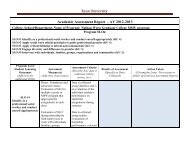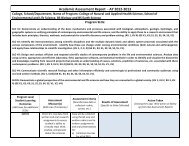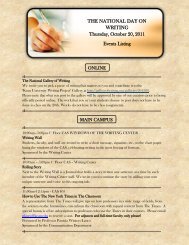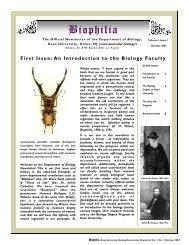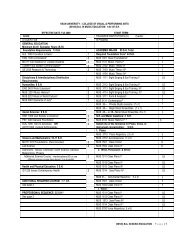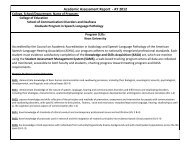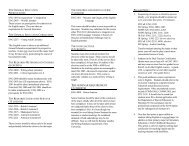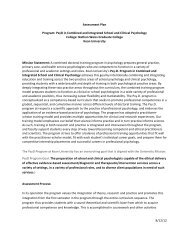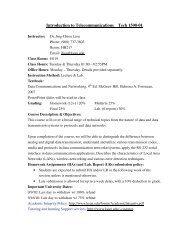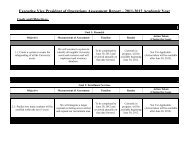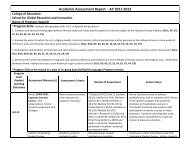Kathy Erteman: Monoprints and Clay - Kean University
Kathy Erteman: Monoprints and Clay - Kean University
Kathy Erteman: Monoprints and Clay - Kean University
Create successful ePaper yourself
Turn your PDF publications into a flip-book with our unique Google optimized e-Paper software.
1<br />
<strong>Kathy</strong> <strong>Erteman</strong><br />
KEan UnivErsity
<strong>Kathy</strong> <strong>Erteman</strong>: <strong>Monoprints</strong> <strong>and</strong> <strong>Clay</strong><br />
Published by <strong>Kean</strong> <strong>University</strong>, 1000 Morris Avenue, Union, New Jersey 07083<br />
www.kean.edu/~gallery<br />
Copyright © 2009 by <strong>Kean</strong> <strong>University</strong>, Union, New Jersey<br />
Essays <strong>and</strong> photographs Copyright © 2009 by individual authors.<br />
All rights reserved. No part of this book may be reproduced in<br />
any form including electronic or mechanical means, photocopying,<br />
<strong>and</strong> information storage <strong>and</strong> retrieval systems, except in the case<br />
of brief extracts for the purpose of critical articles <strong>and</strong> reviews,<br />
without permission in writing from <strong>Kean</strong> <strong>University</strong>.<br />
ISBN 978-1-61658-026-1<br />
All works of art by <strong>Kathy</strong> <strong>Erteman</strong><br />
© <strong>Kathy</strong> <strong>Erteman</strong><br />
Catalogue Design <strong>and</strong> Production<br />
Paul Klonowski • paul@mindsetcs.com<br />
Curator • Neil Tetkowski, Director of <strong>University</strong> Galleries<br />
Cover: Conflict, 2009. Mixed media on Mulberry paper, 14 x 14 in.<br />
Opposite: Image Reverse, 2008. Slip underglaze <strong>and</strong> glaze on whiteware, 16 x 50 x ¼ in.
<strong>Kathy</strong> <strong>Erteman</strong><br />
<strong>Monoprints</strong> <strong>and</strong> <strong>Clay</strong><br />
Karl <strong>and</strong> Helen Burger Gallery<br />
<strong>Kean</strong> <strong>University</strong>
Monoprint Cylinder #2, 2009. Slip underglaze <strong>and</strong> glaze on whiteware, 6 (diam.) x 23 in.
1<br />
<strong>Kathy</strong> <strong>Erteman</strong><br />
<strong>Monoprints</strong> <strong>and</strong> <strong>Clay</strong><br />
November 3 - December 17, 2009<br />
Karl <strong>and</strong> Helen Burger Gallery<br />
<strong>Kean</strong> <strong>University</strong>
Mentor, 2005. Mixed media on Mulberry paper, 13 x 13 in.<br />
4
Introduction<br />
<strong>Kathy</strong> <strong>Erteman</strong> creates art with a sense of confidence <strong>and</strong> style that has evolved over a lifetime<br />
of creative experiences, diverse influences, <strong>and</strong> a great deal of world travel. Her parents were<br />
Dutch <strong>and</strong> Austrian refugees who moved to California to escape the Nazi occupation. In the<br />
1960s <strong>and</strong> 1970s, she came of age in Los Angeles, when design <strong>and</strong> studio art were rapidly<br />
merging with the world of fine art. In the 1980s, she had already made a name for herself<br />
with her well-known black <strong>and</strong> white studio ceramics.<br />
As dem<strong>and</strong> for her work increased, <strong>Erteman</strong> would travel to factories in Thail<strong>and</strong> <strong>and</strong><br />
Peru to oversee production of her designs. Over three decades, she has designed for such<br />
companies as Tiffany, Dansk, <strong>and</strong> Crate & Barrel. Her artwork is included in the permanent<br />
collections of the Smithsonian Institution, the Los Angeles County Museum of Art, <strong>and</strong> the<br />
Taipei Museum of Fine Arts. Recently she lectured at the United Nations headquarters in<br />
New York City <strong>and</strong> worked as a design consultant to ceramic artisans in Tibet through the<br />
United States Agency for International Development.<br />
At mid-career <strong>Kathy</strong> <strong>Erteman</strong> freely works in two <strong>and</strong> three dimensions. Her art includes<br />
architectural installations, encaustic painting, printmaking, <strong>and</strong> even an occasional ceramic<br />
funerary urn. Within this wide range of expression, she consistently makes reference to her<br />
cultural <strong>and</strong> artistic influences: Bauhaus design, Minimalist sculpture, <strong>and</strong> Japanese printmaking.<br />
In 1994 she moved from Northern California to Manhattan, where she continues to<br />
live <strong>and</strong> work. The current one-person exhibition entitled <strong>Kathy</strong> <strong>Erteman</strong>: <strong>Monoprints</strong> <strong>and</strong><br />
<strong>Clay</strong> is featured at <strong>Kean</strong> <strong>University</strong>’s Karl <strong>and</strong> Helen Burger Gallery from November 3 through<br />
December 17, 2009. Paintings on ceramic tile, monoprints, <strong>and</strong> vessel installations from<br />
2005 through 2009 are the focus of the show.<br />
On behalf of <strong>Kean</strong> <strong>University</strong>, I thank <strong>Kathy</strong> <strong>Erteman</strong> for her efforts in the planning of this<br />
comprehensive exhibition, as well as for lending all the works being shown. For the installation<br />
of this show, we are grateful to our graduate assistants Christopher Clark <strong>and</strong> Kelly Murphy.<br />
Special thanks go to <strong>Kean</strong> <strong>University</strong> President Dawood Farahi, Vice President Mark Lender,<br />
<strong>and</strong> Holly Logue, Acting Dean of the College of Visual <strong>and</strong> Performing Arts. We appreciate<br />
their support for the growing exhibition program <strong>and</strong> for this opportunity to investigate the<br />
work of <strong>Kathy</strong> <strong>Erteman</strong>.<br />
Neil Tetkowski<br />
Director of <strong>University</strong> Galleries<br />
5
Golden Light on 18th, 2009. Mixed media on Mulberry paper, 15 x 15 in.<br />
Opposite: Family Portrait #1, 2005. Mixed media on Mulberry paper, 12 x 12 in.<br />
6
1<br />
Works on Paper
Influence, 2005. Mixed media on Mulberry paper, 12 x 12 in.<br />
8
<strong>Kathy</strong> <strong>Erteman</strong><br />
By John Perreault<br />
Certain tendencies can be discerned throughout the world of contemporary ceramics;<br />
humor, super-decorativeness, <strong>and</strong> now mixed-media clay come immediately to mind.<br />
But where is elegance? Where is restraint? These unjustly neglected qualities are embodied<br />
in the subtle, steadfast work of <strong>Kathy</strong> <strong>Erteman</strong>, in which restraint has a strength all its own.<br />
What should one call a “school” of ceramics that crosses under or over all schools, that<br />
has no campus <strong>and</strong> no compass? Its primary characteristic is understatement. It owes more<br />
to northern Europe than to southern Europe. It is more Nordic than it is Italianate. It is, all in<br />
all, aggressively modest.<br />
For several decades, <strong>Erteman</strong>’s vessels have quietly inserted themselves into this tradition.<br />
One thinks of Hans Coper <strong>and</strong> Lucie Rie; one thinks of the Natzlers <strong>and</strong> even the more dramatic<br />
work of Elsa Rady. This tradition—<strong>and</strong> perhaps tradition is a better term than school—comes<br />
with a sense of responsibility. Art works must be made for the home, not the palace.<br />
Therefore, one does not have to justify <strong>Erteman</strong>’s feeling for affordable editions, h<strong>and</strong>made<br />
<strong>and</strong> even mass-produced dinnerware. Such productions go with the socially conscious<br />
territory of Apollonian ceramics. The goal of <strong>Erteman</strong>’s dinnerware is to provide a platform<br />
for food. The goal of her artware is the kind of contemplation that only the most rarified of<br />
ceramics can provide.<br />
Restraint, however, does not necessarily preclude evolution or development. Known for<br />
her utilization of black-<strong>and</strong>-white surface treatments, <strong>Erteman</strong> has recently unveiled her<br />
forays into subdued color in a series of monochromatic wall squares, which come in sets.<br />
9
Veiled, 2009. Mixed media on Mulberry paper, 14 x 14 in.<br />
10
Resolve, 2009. Mixed media on Mulberry paper, 14 x 14 in.<br />
The seemingly solid <strong>and</strong> sometimes quite thick squares are actually hollow, which allows<br />
them to be hung directly on the wall. The artist’s four-square arrangements must be<br />
meticulously followed. These wall pieces are not variables: they are not tiles <strong>and</strong> they<br />
are not paintings. They are elegant ceramic variations on the minimalist grid, one part<br />
Agnes Martin, one part Sol LeWitt, but with an investigation of color that is strictly <strong>Erteman</strong>.<br />
But there is more than the wall pieces going on here.<br />
11
Empty Lot, 2005. Mixed media on Mulberry paper, 13 x 13 in.<br />
12
Study with Glaze #2, 2007. Mixed media on Mulberry paper, 18 x 24 in.<br />
Noting that inks <strong>and</strong> paints can be transferred using clay, <strong>Erteman</strong> has been investigating<br />
the monoprint, first on cylindrical vessels <strong>and</strong> then, by opening up the cylinders, on flat,<br />
rectangular tablets, which are most often shown in simple groupings. Using the monoprint<br />
technique, she has developed a rich vocabulary of circles <strong>and</strong> ellipses. She associates the<br />
configurations with unselfconscious social arrangements that may be observed on the street<br />
or at informal gatherings. Her use of monoprint techniques on clay surfaces references the<br />
classical uses of accident in ceramic decoration <strong>and</strong> the give <strong>and</strong> take between application<br />
<strong>and</strong> surface. Ceramics <strong>and</strong> the monoprint are such a comfortable fit that it is astounding no<br />
one has thought of it before. Other techniques, such a transfer prints, decals, <strong>and</strong> screenprinting,<br />
have been used in the production of commercial dinnerware <strong>and</strong> parodied in art<br />
ceramics, but never, so far as I know, in the humble one-off monoprint.<br />
<strong>Erteman</strong> has usually worked with tightly thrown or molded vessel forms, so that the<br />
monoprint images provide a foil to the precision, or vice versa. <strong>Erteman</strong> is also obviously<br />
attracted to the low-tech, highly tactile quality of the process. The rectangular tablets <strong>and</strong><br />
13
Guide, 2005. Mixed media on Mulberry paper, 13 x 13 in.<br />
14
Study with Glaze #1, 2007. Mixed media on Mulberry paper, 18 x 24 in.<br />
the wall squares highlight flat surfaces, as well as the kind of compositional closure that<br />
vessels deny, marking a new stage in <strong>Erteman</strong>’s career. As if migrating from the wall squares,<br />
these blushes <strong>and</strong> stains of subdued color are now slowly making an appearance in the<br />
monoprint tablets.<br />
The cerebral wall squares <strong>and</strong> the lyrical monoprint tablets carry forward <strong>Erteman</strong>’s<br />
commitment to clay <strong>and</strong> to a classic, conscientious modesty, as they allow room for artistic<br />
growth. One is not surprised that the same kinds of emotions that prevail in her earlier work<br />
are also celebrated in these new endeavors.<br />
John Perreault is an art critic, poet, <strong>and</strong> artist who writes regularly at www.artsjournal.com/artopia.<br />
He has written about contemporary art for Art News, Artforum, American Craft Magazine, <strong>and</strong> numerous<br />
other publications. He was a Senior Curator at the American Craft Museum <strong>and</strong> is a past president<br />
of the New York Section of the International Association of Art Critics.<br />
15
Family Portrait #2, 2005. Mixed media on Mulberry paper, 12 x 12 in.<br />
16
Untitled, 2009. Mixed media on Mulberry paper, 15 x 15 in.<br />
17
Loner, 2007. Slip underglaze <strong>and</strong> glaze on whiteware, 18 x 16 x ¼ in.<br />
Opposite: Guanzhi, 2009. Slip underglaze <strong>and</strong> glaze on whiteware, 16 x 72 x ¼ in.<br />
18
1<br />
Works in Ceramics
Blue Monoprint Tablets, 2007. Slip underglaze <strong>and</strong> glaze on whiteware, 11 x 33 x 1 in.<br />
20
the Physical <strong>and</strong> the visual<br />
By Janet Koplos<br />
We are all the products of our experiences. <strong>Kathy</strong> <strong>Erteman</strong>’s distinctive place in contemporary<br />
American ceramics may in part be attributed to the influences of her background: she was<br />
born to European immigrants displaced from Vienna <strong>and</strong> Amsterdam by World War II. The<br />
strong design traditions in both those cities may have given her a first vocabulary. In Southern<br />
California, where she grew up, modernist design <strong>and</strong> architecture were all around her, both<br />
the European strain—exemplified in the exquisite ceramics of the émigrés Gertrud <strong>and</strong> Otto<br />
Natzler, whose work <strong>and</strong> lifestyle she admired—<strong>and</strong> in the new ideas characteristic of that<br />
time <strong>and</strong> place. One of those was the Finish Fetish style, in which painters, sculptors, <strong>and</strong><br />
ceramists showed an interest in the particularities of surface, often glossy perfection or intense<br />
color. Feminism, along with <strong>Erteman</strong>’s experience helping with Judy Chicago’s collaborative<br />
Dinner Party project, was another. This combination of ideas <strong>and</strong> influences is specific to<br />
<strong>Erteman</strong>’s life <strong>and</strong> frees her from any danger of following someone else’s manner. Thus she<br />
cannot be pigeonholed, <strong>and</strong> her work in every category has achieved an admirable integrity.<br />
<strong>Erteman</strong>’s ceramics, like all great works in that medium, insist on their own physicality<br />
when they are seen in person. Even ceramic sculpture—work not intended for use—emphasizes<br />
tactility <strong>and</strong> often relates to the human body through its volume, if not through its actual<br />
size (although frequently it is through size, as it reflects the measurement of the maker’s h<strong>and</strong><br />
or arm’s length). <strong>Erteman</strong> has made many objects for use, <strong>and</strong> though that is less central to<br />
her current work, a viewer looking at her vessels may still feel the urge to pick them up <strong>and</strong><br />
test their weight, to run a finger along a rim, to rest a palm against a slick patch of glaze or a<br />
21
Naar Boven 2006. Slip underglaze <strong>and</strong> glaze on whiteware, 11 x 28 x ¼ in.<br />
crusty-looking expanse of a dryer, mottled surface. All her work, even the new panel series<br />
that holds a middle ground between drawing <strong>and</strong> painting <strong>and</strong> the ceramic tradition of tile,<br />
occupies three-dimensional space <strong>and</strong> thus feels familiar to the viewer, who similarly exists<br />
in space. When the work itself doesn’t have much depth, she hangs it from a bar so that it<br />
projects slightly from the wall <strong>and</strong> seems thick.<br />
Viewing the photographic representations in this catalogue offers an entirely different<br />
pleasure in the consideration of <strong>Erteman</strong>’s works. One can for a moment disregard their<br />
satisfying physicality to concentrate exclusively on their visual qualities. These purely visual<br />
aspects are certainly not the total, but photographs do offer the opportunity to consider<br />
some qualities more purely, in isolation, before turning back to enjoy the experience of<br />
the actual work as a whole.<br />
Flipping through the images of ceramics on these pages can evoke the compacted feeling<br />
of watching fast-paced movie previews: one association is quickly crowded out by another.<br />
As I jumped from one image to the next in viewing the full selection of work in the show,<br />
I was reminded of Minimalist sculpture, machine belts, Japanese food dishes, Chine-collé<br />
prints, h<strong>and</strong>made paper, monochrome painting, tree trunks, third-world basketry, peeling<br />
advertising posters, tropical leaves, De Stijl compositions, architectural columns, rusting steel,<br />
Opposite: Metro, 2008. Slip underglaze <strong>and</strong> glaze on whiteware, 38 x 10 x ¼ in.<br />
23
Granite Boat Vessel, 2008. Slip underglaze <strong>and</strong> glaze on whiteware, 5 x 24 x 11 in.<br />
Aaron Siskind photographs, boats, trays of food. Certainly one of the strongest aspects of<br />
<strong>Erteman</strong>’s work is the subtle surface character she develops (also present in her works on<br />
paper, which will be discussed below). This is true despite—or perhaps because of—her<br />
limited use of color. In works such as Arc she organizes a very vague overall black-<strong>and</strong>-white<br />
treatment, in some parts milky-looking <strong>and</strong> elsewhere appearing abraded; she interrupts that<br />
looseness with sharp-edged squarish patches, which are widely spaced in the composition.<br />
These areas suggest a different reality. It is as if we are looking at a satellite view of clouds<br />
(the milky parts) with inset photographs of rock faces (the abraded parts).<br />
The surface of Arc can also be described without making these kinds of associations.<br />
In purely formal terms, it is a fluid, horizontally compressive composition of white on black<br />
punctuated by contrastingly rigid straight lines; the vertical lines seem to interrupt forcefully<br />
while the horizontal ones, paralleling the longer top <strong>and</strong> bottom edges of the surface, seem<br />
to point onward, as if the composition could extend forever. And when Arc is analyzed as a<br />
three-dimensional work, or seen in person so that its volume cannot be ignored, even in a<br />
moment of indulgence, the viewer notes that the angular patches occupy the ends of a long<br />
side of the form, so that they appear to wrap around rather than terminate, emphasizing that<br />
this work is not, in fact, two-dimensional. The contrasting, entirely black interior also visually<br />
pushes the mottled surface out into space, again underscoring dimensionality.<br />
24
Arc Vessel, 2008. Slip underglaze <strong>and</strong> glaze on whiteware, 8 x 23 x 5 in.<br />
This kind of examination of opposing effects can be applied to all the images of ceramic<br />
objects printed in this catalogue. Columnar works such as the three monoprint cylinders insist<br />
on the curvature of their surfaces, even in photographs. The faint shadows in the white background<br />
of the top two-thirds of these photos visually reinforce the curvature of these slip-cast<br />
forms. At the same time, however, flattening effects are produced by the matte black segments.<br />
The cylinders are elegant, smooth, <strong>and</strong> they evoke contemporary design, offering less sense<br />
of touch than some other works. Yet the motif used is unlike the perfection of mass-produced<br />
design works <strong>and</strong> recalls aged plaster. <strong>Erteman</strong> plays one aspect against the other, so that<br />
viewers cannot capture the work at a glance but must spend time with it. Always her works<br />
present an apparent simplicity—uncomplicated forms <strong>and</strong>, as noted, limited color—which<br />
turns out to be full of subtle complications.<br />
<strong>Erteman</strong>’s various tile-like pieces, which she makes in different sizes, as solo objects or<br />
in diptychs <strong>and</strong> triptychs, are easily compared as well to other two-dimensional genres,<br />
such as paintings or prints. However, they retain thickness—sometimes enough to suggest<br />
that they are hollow—<strong>and</strong> an appearance of weight. The irregular surface plane keeps them<br />
in the realm of the physical rather than offering the illusionary window into another space that<br />
painting <strong>and</strong> photography routinely provide. One piece, exceptionally, is half blue, but mostly<br />
<strong>Erteman</strong> manipulates contrasts of value (light/dark) at the same time that she plays softness<br />
25
26<br />
Shallow Pod #1, 2008. Slip underglaze <strong>and</strong> glaze on whiteware, 7 x 26 x 3 in.<br />
Shallow Pod #2, 2008. Slip underglaze <strong>and</strong> glaze on whiteware, 7 x 26 x 2 in.<br />
Striped Pod, 2008. Slip underglaze <strong>and</strong> glaze on whiteware, 4 x 25 x 8 in.
Blade Vessel, 2006. Slip underglaze <strong>and</strong> glaze on whiteware, 5 x 18 x 3 in.<br />
against precision to create an impression of shallow, ambiguous space. Loner, the largest<br />
single piece, again may recall a plaster wall infected by time. She applies a number of white<br />
egg shapes to the shadowy white-on-black ground, along with a single black egg shape. It is<br />
not clear where they exist in space, but they hold their uncertain depth <strong>and</strong> invite us to study<br />
the details of placement.<br />
In photographs the white shapes read as faintly outlined in black; they seem to be “detached<br />
shapes” casting minuscule shadows. But that is not really the case. <strong>Erteman</strong> engages in<br />
layering, <strong>and</strong> she uses stencils to “reserve” a spot of undercolor while she brushes a different<br />
pigment over the area; or she applies a color to a slab of clay in which she has made holes<br />
<strong>and</strong> presses it to the surface of the panel to transfer the color—just like a monoprint executed<br />
in more conventional printmaking materials. Those seemingly detached shapes are in fact<br />
lower than the rest of the surface, <strong>and</strong> sometimes they show narrow outlines of a different,<br />
mostly obscured color. Perhaps they seem to advance because they are less inflected <strong>and</strong><br />
therefore more emphatic. The effect is elusive, confusing, fascinating.<br />
27
Guanzhi Two, 2009. Slip underglaze <strong>and</strong> glaze on whiteware, 18 x 80 x ¼ in.<br />
28<br />
This impact of “detached” elements, which she has been exploring for about four years,<br />
appears again in most of her paintings on paper. The most striking examples are the works<br />
called Influence <strong>and</strong> Mentor, in both of which two large rounded shapes visually operate well<br />
in front of the background. These works are given titles that could have emotional implications.<br />
In both works, one of the shapes is larger <strong>and</strong> dominant. In Influence, there is barely enough<br />
room for the small shape of contrasting color, which seems to be overwhelmed by an outside<br />
influence that does not match its own character. In Mentor the colors match <strong>and</strong> the large <strong>and</strong><br />
small shapes occupy a sympathetic <strong>and</strong> comfortable propinquity, together but not colliding.<br />
Other works on paper may correspond directly to the treatment of the ceramic surfaces:<br />
Family Portrait <strong>and</strong> Portrait 2 consist of irregular circles, large in the former <strong>and</strong> of medium<br />
size in the latter, recalling the black dots on the ceramic diptych called Naar Boven. Something<br />
slightly different happens in Golden Light on 18th, in which a swarm of small black dots<br />
occupies a warm golden shape that is approximately circular (as they are), upon a horizontally<br />
furrowed black-<strong>and</strong>-white background. One imagines the dots as people swarming across<br />
an intersection perhaps, with the square frame st<strong>and</strong>ing in for a window. But such a literal<br />
interpretation cannot be sustained, because the dots seem unaffected by gravity in their<br />
orientation <strong>and</strong> organization. The formal analysis used on the ceramic compositions is more<br />
appropriate here: the black dots float in an undefined depth.<br />
In these recent works, <strong>Erteman</strong> eschews the functional designs that previously occupied<br />
her but otherwise continues her practice of producing reductive <strong>and</strong> orderly shapes with
Plein, Gray/Black Vessel, 2008. Slip underglaze <strong>and</strong> glaze on whiteware, 7 x 25 x 7 in.<br />
evocative surfaces. The specifics are quite different, the general character quite consistent.<br />
She is committed to abstraction <strong>and</strong> suggestion rather than depiction. Her palette is sober yet<br />
the works are not quite closed enough to be called austere: they are sometimes atmospheric,<br />
sometimes even sensuous. In this considered, evolved body of work, <strong>Erteman</strong> maps out a<br />
place for herself that for the most part escapes the common stylistic categories of ceramics<br />
but retains its particularities, even as she asks the formal questions of any abstract art.<br />
Janet Koplos has written widely on art, architecture, <strong>and</strong> design <strong>and</strong> has long had a special interest<br />
in contemporary craft. Koplos is the guest editor of American Craft Magazine, <strong>and</strong> former senior<br />
editor at Art in America in New York City.<br />
29
Figure Eight Vessel, 2006. Slip underglaze <strong>and</strong> glaze on whiteware, 5 x 21 x 2 in.<br />
Green Vessel, 2009. Slip underglaze <strong>and</strong> glaze on whiteware, 25 x 7 x 5 in.<br />
Steel <strong>and</strong> Rust Vessel, 2006. Slip underglaze <strong>and</strong> glaze on whiteware, 5 x 17 x 5 in.<br />
30
Monoprint Cylinder #3, 2009. Slip underglaze <strong>and</strong> glaze on whiteware, 6 (diam.) x 23 in.<br />
31
32<br />
Monoprint Cylinder #1, 2009. Slip underglaze <strong>and</strong> glaze on whiteware, 6 (diam.) x 23 in.
Tumble, 2007. Slip underglaze <strong>and</strong> glaze on whiteware, 13 x 52 x ¼ in.<br />
<strong>Kathy</strong> <strong>Erteman</strong> Biography<br />
<strong>Kathy</strong> <strong>Erteman</strong> is a ceramic artist <strong>and</strong> designer based in New York City whose career<br />
spans three decades. Her work has been widely exhibited <strong>and</strong> is represented in important<br />
collections, such as the Smithsonian Institution, the Los Angeles County Museum of Art,<br />
<strong>and</strong> the Taipei Museum of Fine Arts. She has been commissioned to design for the ceramic<br />
industry by such prominent firms as Tiffany & Co. <strong>and</strong> Crate & Barrel. Her work has also<br />
been published in books <strong>and</strong> periodicals, including the New York Times, Metropolitan<br />
Home, <strong>and</strong> Artforum. In addition to her studio work, <strong>Erteman</strong> is known as an inspiring<br />
teacher <strong>and</strong> has taught at Parsons School of Design, the Brooklyn Museum, <strong>and</strong> the<br />
Bezalel Academy of Art in Jerusalem. She currently teaches at Greenwich House Pottery<br />
in New York City. Her many awards include a New York Foundation for the Arts fellowship<br />
<strong>and</strong> an eBay artist technology grant.<br />
<strong>Kathy</strong> <strong>Erteman</strong> is the daughter of Austrian <strong>and</strong> Dutch refugees who immigrated to Los<br />
Angeles in the 1940s. The European sensibilities of her family <strong>and</strong> the progressive postwar<br />
energy of Southern California provided the early foundation of her artistic point of view.<br />
Modernist architecture <strong>and</strong> design, Abstract Expressionist painting, <strong>and</strong> the Minimalist<br />
33
Shallow Pod #3, 2007. Slip underglaze <strong>and</strong> glaze on whiteware, 7 x 26 x 2 in.<br />
Rectangle, 2007. Slip underglaze <strong>and</strong> glaze on whiteware, 1 x 21 x 9 in.<br />
Black <strong>and</strong> White Pod, 2008. Slip underglaze <strong>and</strong> glaze on whiteware, 4 x 28 x 7 in.<br />
34
sculpture movement were at the height of their influence during her youth. The celebrated<br />
ceramic works of Gertrud <strong>and</strong> Otto Natzler, Lucie Rie <strong>and</strong> Hans Coper, among others,<br />
were part of the restrained, graceful aesthetic she was exposed to at the time. While still<br />
in high school, <strong>Erteman</strong> joined a ceramic studio founded by Robert Brent, a pioneer of the<br />
contemporary electric potter’s wheel. Here she began to work in clay, making singular modern<br />
forms reflecting both early twentieth-century European design <strong>and</strong> the renegade influence<br />
of Southern California. The exciting “no-rules” environment there during the late 1960s<br />
encouraged experimentation <strong>and</strong> blurred the lines between craft, popular culture, <strong>and</strong> fine art.<br />
The brilliant <strong>and</strong> obsessively honed surfaces <strong>and</strong> use of industrial materials of Los Angeles<br />
Finish Fetish artists Craig Kauffman, Robert Irwin, Larry Bell, Ken Price, <strong>and</strong> James Turrell<br />
attracted her attention. This freewheeling approach to clay has remained a defining element<br />
of her work throughout her career.<br />
As a young artist in Los Angeles, <strong>Erteman</strong> followed the work of artists associated with the<br />
Chouinard Art Institute—Adrian Saxe, Ralph Bacerra, <strong>and</strong> Elsa Rady. Their well-crafted<br />
<strong>and</strong> highly stylized vessels gave her license to go beyond the strict but unspoken rules of<br />
traditional pottery-making. This enabled her to incorporate such industrial methods as slip<br />
casting, jiggering, <strong>and</strong> plaster turning into her work <strong>and</strong> to develop her signature vessel forms.<br />
<strong>Erteman</strong> received a BFA from California State <strong>University</strong>, Long Beach. After graduation<br />
she worked with the artist Judy Chicago on her groundbreaking feminist work The Dinner<br />
Party. In 1981 <strong>Erteman</strong> established a studio in Benicia, California, a Bay area town that<br />
was home to many celebrated artists working in clay, such as Robert Arneson, Manuel Neri,<br />
S<strong>and</strong>y Simon, <strong>and</strong> Robert Brady. In 1994 she moved to New York City, where she currently<br />
lives <strong>and</strong> maintains a studio near Union Square.<br />
35
36<br />
Checklist<br />
<strong>Kathy</strong> <strong>Erteman</strong>: <strong>Monoprints</strong> <strong>and</strong> <strong>Clay</strong><br />
Ceramic Wall Pieces<br />
1. Blue Monoprint Tablets, 2007, 11 x 33 x 1 in.<br />
2. Guanzhi, 2009, 16 x 72 x ¼ in.<br />
3. Guanzhi Two, 2009, 18 x 80 x ¼ in.<br />
4. Image Reverse, 2008, 16 x 50 x ¼ in.<br />
5. Loner, 2007, 18 x 16 x ¼ in.<br />
6. Naar Boven, 2006, 11 x 28 x ¼ in.<br />
7. Metro, 2008, 38 x 10 x ¼ in.<br />
8. Tumble, 2007, 13 x 52 x ¼ in.<br />
Ceramic Vessels<br />
9. Arc Vessel, 2008, 8 x 23 x 5 in.<br />
10. Blade Vessel, 2006, 5 x 18 x 3 in.<br />
11. Figure Eight Vessel, 2006, 5 x 21 x 2 in.<br />
12. Granite Boat Vessel, 2008, 5 x 24 x 11 in.<br />
13. Plein, Gray/Black Vessel, 2008, 7 x 25 x 7 in.<br />
14. Steel <strong>and</strong> Rust Vessel, 2006, 5 x 17 x 5 in.<br />
15. Striped Pod, 2008, 4 x 25 x 8 in.<br />
16. Rectangle, 2007, 1 x 21 x 9 in.<br />
17. Shallow Pod #1, 2008, 7 x 26 x 3 in.<br />
18. Shallow Pod #2, 2008, 7 x 26 x 2 in.<br />
19. Shallow Pod #3, 2007, 7 x 26 x 2 in.<br />
20. Monoprint Cylinder #1, 2009, 6 (diam.) x 23 in.<br />
21. Monoprint Cylinder #2, 2009, 6 (diam.) x 23 in.<br />
22. Monoprint Cylinder #3, 2009, 6 (diam.) x 23 in.<br />
23. Black <strong>and</strong> White Pod, 2008, 4 x 28 x 7 in.<br />
24. Green Vessel, 2009, 25 x 7 x 5 in.<br />
Works on Paper<br />
25. Mentor, 2005, 13 x 13 in.<br />
26. Guide, 2005, 13 x 13 in.<br />
27. Empty Lot, 2005, 13 x 13 in.<br />
28. Family Portrait #1, 2005, 12 x 12 in.<br />
29. Family Portrait #2, 2005, 12 x 12 in.<br />
30. Influence, 2005, 12 x 12 in.<br />
31. Study with Glaze #1, 2007, 18 x 24 in.<br />
32. Study with Glaze #2, 2007, 18 x 24 in.<br />
33. Untitled, 2009, 15 x 15 in.<br />
34. Golden Light on 18th, 2009, 15 x 15 in.<br />
35. Veiled, 2009, 14 x 14 in.<br />
36. Conflict, 2009, 14 x 14 in.<br />
37. Resolve, 2009, 14 x 14 in.<br />
Note: Measurements are represented in inches<br />
(height x width x depth). Unless otherwise noted,<br />
all ceramic surfaces are a combination of slip<br />
underglaze <strong>and</strong> glaze on whiteware. All works<br />
on paper are mixed media, gouache, casein paint,<br />
tempera, <strong>and</strong> etching ink on Mulberry paper.<br />
All works are collection of the artist.<br />
Opposite: Naar Boven 2006. Slip underglaze <strong>and</strong> glaze on whiteware, 11 x 28 x ¼ in. (detail)
<strong>Kean</strong> <strong>University</strong><br />
Karl <strong>and</strong> Helen Burger Gallery<br />
Union • New Jersey • 908 -737-0392 • www.kean.edu/~gallery/



